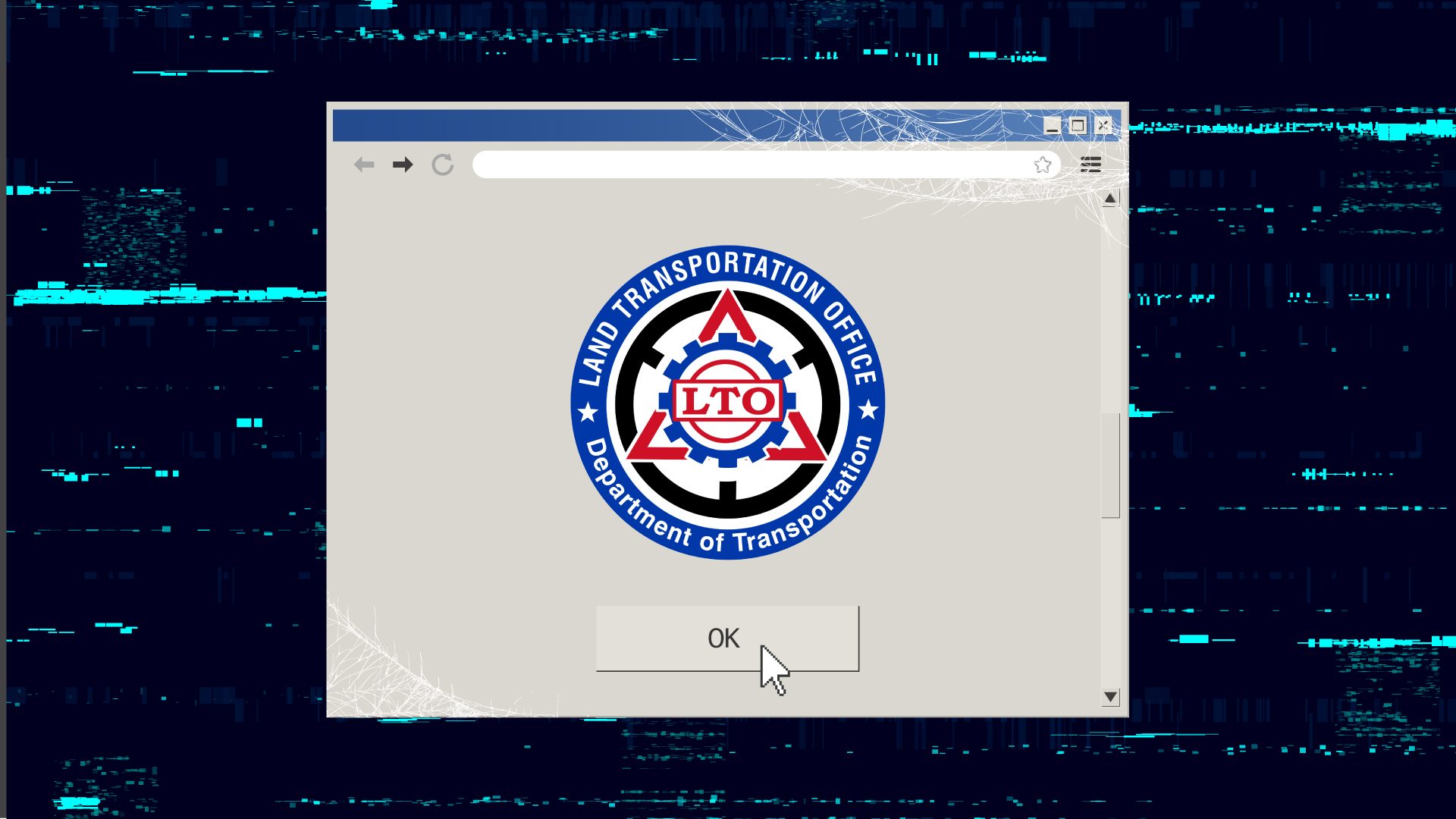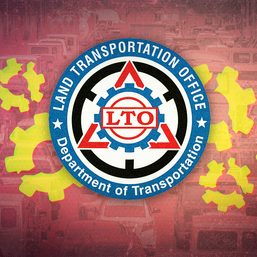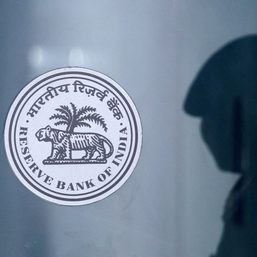SUMMARY
This is AI generated summarization, which may have errors. For context, always refer to the full article.

The Land Transportation Office (LTO) was supposed to have transitioned to a new information technology system years ago. But the agency’s continuing decision to run its old and new IT systems in parallel has opened loopholes for fraud and cost motorists billions a year in computer fees.
Right now, there are IT systems for the LTO operated by two separate, competing companies: Stradcom Corporation and a joint venture headed by German firm Dermalog.
Stradcom, which has managed the aging LTO IT system since the late 1990s, has been part of a phaseout agreement signed in 2016. Meanwhile, Dermalog’s joint venture is the one behind the government-owned Land Transportation Management System (LTMS).
How can there be two separate IT systems managing data involving millions of motorists and motor vehicles? If there is a new system, why hasn’t the old one been phased out? These are where the problems and loopholes lie.
The result: a system that allows failed roadworthiness tests and smuggled ultraluxury Bugatti Chirons to slip through.
Motorists have also had to suffer through slower service times in instances when their data is registered in one IT system but not in the other – all while having to pay P169 every time they transact with LTO using the old system.
Failed emission tests, smuggled cars and more
It’s an open secret that many motorists and huge corporations – with their fleet of vehicles – skip mandated roadworthiness tests for their vehicles. A source familiar with the registration renewals and insurance business told Rappler, on condition of anonymity, that certain inspection and emission testing centers offer “special” or “no-show” services, essentially allowing motorists to pay their way to a guaranteed passing mark.
Tests processed through the LTMS are all electronically transmitted, meaning it’s harder to tamper with inspection results. But since the old IT system is also still running, could there have been some way to bypass that system to get these spurious test results through?
Earlier in March 2024, sources close to the LTO confirmed to Rappler that a motorist with a motorcycle that failed roadworthiness tests still managed to renew the mandatory motor vehicle registration in an LTO office in Central Luzon using the Stradcom system.

Based on a report by a private motor vehicle inspection center (PMVIC), the motorcycle failed both its carbon monoxide (CO) emission and rear brake tests. For motorcycles registered for the first time on July 1, 2017 and onwards, CO percentage by volume should only be 2.5% or less. This motorcycle’s emission test showed it emitted 3.32%, as encircled in red.
According to the Department of Transportation, the results of most road worthiness tests conducted by PMVICs – such as the brake and headlights tests – are only recommendatory. However, passing the emission test is mandatory for all motor vehicles to be registered and renewed with the LTO.

Yet on the same day, an LTO-issued official receipt seen by Rappler showed that the vehicle owner was able to renew the motorcycle’s registration, a process that requires the motor vehicle to obtain a passing mark on its emission test or motor vehicle inspection report.
The only way this motorcycle’s registration could have been renewed is by using the old Stradcom system. That’s because the PMVIC’s failing report would have already been automatically submitted to the LTMS, preventing the motorcycle from being renewed there. The P169 “comp fee” on the official receipt, encircled in red, also indicates that it was processed through the old IT system – not the new LTMS.
This is also why fixers and LTO personnel who allegedly collude with them are “allergic” to the LTMS, multiple industry and LTO sources told Rappler.
Rappler has reached out to Stradcom and LTO multiple times for their comment on the no-show services that continue to be facilitated, and whether Stradcom’s system has safeguards against these. Both Stradcom and LTO have not responded.
A 2020 Journal Online post, however, spoke about “system innovations” in the LTO’s IT system. It said that Stradcom’s “Private Emission Testing Center Information Technology Facility links LTO and private emission testing centers to enable electronic uploading of data and authentication of records prior to motor vehicle registration.”
Quoting Stradcom spokesperson Lorie Bundoc, the post said that this computerized system was supposed to “help ensure transparent transactions, objective decision-making, and cut red tape. Our system provides information on irregularities in transactions and flags incomplete applications.”
But there were other problems, too. A former LTO assistant secretary also told Rappler that before the agency switched fully to the LTMS, forging driver’s licenses and medical records was easy to do under the old system. That’s because Stradcom’s system relied on scanning paper documents of driver’s license exam and medical test results, which could be tampered with before they were uploaded.
The retired LTO head also said he once monitored a driving school with only one instructor and small classrooms yet it managed to issue more than a thousand certificates in a span of just two to three months.
There is also the recent and high-profile Bugatti Chiron fiasco. Two of the luxury sports car – among the world’s most expensive – were smuggled into the country and even successfully registered in the LTO. These vehicles were not registered in the new LTMS, but rather in Stradcom’s old IT system, according to several sources and an initial investigation by the LTO-NCR.
This would have been impossible, if not more difficult, to do under the LTMS because registering a smuggled vehicle in the system would leave a glaring audit trail through the fingerprint scanner that would immediately expose the perpetrator’s identity.
Industry sources told Rappler that the LTMS is equipped with biometrics verification so that every renewal and approval requires the evaluator to scan fingerprints. A “liveliness” feature is also able to detect whether the fingerprint scanned is faked or somehow recorded.
Rappler also learned from individuals handling the LTMS that there was actually an attempt to use the new IT system to register the Bugattis, but because the transaction required a fingerprint scan, the attempt was abandoned. This was likely when the perpetrators instead turned to Stradcom’s system to complete the registration of the smuggled vehicles.
How this harms you: More fees, slower service
But even if you aren’t concerned about these cases of fraud, the parallel use of the LTO’s new and old system can still affect you. For one, you simply have to pay more.
If you’ve transacted with the LTO, you may have noticed on your official receipt that you were charged P169 for “comp fee,” or computer fees. That amount does not go to the LTO or government, but instead to Stradcom – the company managing the LTO’s old IT system.

The two official receipts above were issued by the LTO around the same time in October 2023. On the left is an initial motor vehicle registration of a sports utility vehicle in Muntinlupa City, and crucially, the motorist was not charged an additional computer fee because the registration was processed through the LTMS.
On the right is another initial motor vehicle registration, this time of a motorcycle in the LTO National Capital Region (NCR)’s West Regional Office. Because it was processed under Stradcom’s system, the motorist had to pay an additional P507 – P169 multiplied thrice since an initial registration lasts for three years.
Why do you need to pay computer fees to Stradcom? Under Stradcom’s build-own-operate (BOO) scheme with the LTO, the government does not pay for the set-up, operation, or maintenance of its IT system. Stradcom does. In return, the company recovers this through fees. Motorists have to pay P169 for every LTO transaction. A source that operates a PMVIC also told Rappler that they have to pay P45 every time that they upload inspection test results into the Stradcom system.
Way back in October 2005, a report by the Commission on Audit (COA) already warned that the public would have to bear the cost. In the COA Management Services Report No. 2004-03B, the state auditor said that “the interest of the public was not adequately protected under existing condition where IT fees are imposed without taking into account its acceptability to the end-users and establishment of the rate of return,” pointing out that an increase ranging from 4% to 440% of the LTO base fee at the time was added to the IT fees.
Meanwhile, motorists are charged no extra fees when transactions are done with the LTO through the LTMS. That’s because the government already invested around P8 billion for the hardware and software components of the IT project, which is now owned by the government as well.
Sources within the LTO told Rappler that motorists aren’t given the option of which IT system to use when registering their vehicle, renewing their license, or otherwise transacting with the agency. It’s apparently up to LTO personnel to decide where to encode the motorists’ data, with some LTO offices literally having two computers operating the two different IT systems beside each other.
It also seems as if these problems were foreshadowed in the 2005 COA report, which flagged how Stradcom’s contract lacked continuity.
“The BOO scheme for the LTO IT Project is disadvantageous as this would not provide project continuity. At the end of the 10-year concession period, the project has to be started anew as only the database will be owned by the LTO. The IT facilities and application systems, the costs of which were recovered through the collection of IT fees from the public, remained with the project proponent,” the COA said in its observations.
Rappler sought comment from both Stradcom and LTO on the two IT system setup and the computer fees charged to motorists. Neither have replied, even after multiple follow-ups with their respective spokespersons.
In a past letter to the editor in the Philippine Star that responded to an open letter that it had published, Stradcom defended its BOO arrangement, saying that it provided the “strongest impetus to make sure that the LTO IT System is always running efficiently since any downtime or slowdown in the LTO IT System would translate directly to a negative impact on Stradcom’s revenue.”
“In fact, the existing LTO IT System is even better than the LTMS as delivered by the Dermalog Joint Venture because the LTO IT System as acquired by the government under a BOO arrangement [is] at zero cost to the government, unlike the LTMS which was acquired using the direct mode of procurement wherein the government had to appropriate funds therefor,” Stradcom wrote.
Meanwhile, LTO Assistant Secretary Vigor Mendoza II, in an Inquirer report, also defended the current arrangement and the collection of computer fees: “[T]he reason behind the charging of computer fees is plain and simple: it is being done in areas where LTMS is not yet functional due to internet connectivity [problems], and for the convenience of LTO clients who would seriously be affected if we chose to revert to manual processing, rather than taking advantage of the existing old system.”
Mendoza also said that the payment of computer fees was limited to only “a handful of specific transactions that cannot be processed under the LTMS.” Yet Metro Manila, one of the areas least likely to have internet connectivity issues, continues to use the old system.
No chairs, no tables, out of sync
Almost 10 years after COA’s report, we’re now seeing the dangers it cited manifest, sometimes in almost comically petty ways. A source involved in the Stradcom-Dermalog system transition told Rappler that as early as August 2019, the LTMS system itself was ready to go live.
But what wasn’t ready were the LTO offices because in these offices, the chairs, tables, wiring, and even electrical outlets were owned by Stradcom. LTO personnel in certain offices reportedly couldn’t even place the new system’s computers on the tables because Stradcom site supporters would tell them that the tables belonged to Stradcom.
There is also one final, painful cost to running two parallel IT systems: inefficiency. Those transacting with LTO may, at times, notice long delays in processing what should be a simple motor vehicle registration renewal. That has prompted many questions on whether the LTMS leads to slower service times than the old system.
But sources in the LTO told Rappler that the delays come from having two parallel systems whose databases are not synced. Stradcom has reportedly failed to periodically submit its updated databases to Dermalog.
Stradcom has repeatedly asserted that it turned over its electronic database 10 times to the LTO. However, its last submission of updated data in June 2023 contained data only up to December 31, 2022 – which means that registration data for new motor vehicles in 2023 were excluded. LTMS needs the up-to-date data to complete transactions.
What this further means is that when renewal time comes, motorists whose vehicles were registered under Stradcom will find it difficult to renew since their registration information won’t show up in the LTMS. The process of fixing this is long and painful: first, a ticket has to be filed with the LTO’s Management Information Division, which would then need at least two weeks to import the data from Stradcom to LTMS.
And these are not just isolated cases. Data from the LTO’s annual report shows that from January to September 2023, there were 1,839,164 new motor vehicles registered. But based on LTMS data obtained by Rappler, only 333,152 new vehicles were registered under the LTMS over the same period. This suggests that potentially more than 1.5 million motorists whose initial vehicle registrations were made under Stradcom could face delays when the time comes to renew their vehicle registration.
Motorcycles – which make up the bulk of registered vehicles – will be the most adversely affected. Prior to an LTO memorandum circular that took effect on May 15, 2023, motorcycles with engine displacement of 200cc and below were required to renew their registration every year. This means that motorcycles not covered by the LTO circular will need to renew their registration – and could be in for a long wait if their data is stuck in another IT system.
Mendoza did not respond to Rappler’s requests for comment. He had previously claimed in an Inquirer report that there were no delays in motor vehicle registration due to data migration issues since “97 percent of transactions under this process have already been completed.” The few instances of delay, he said, happen only “during LTMS downtimes.”
Mendoza also claimed in the same report that Stradcom has submitted all of the “legacy data” in line with his “aggressive drive to fully migrate to the new IT system.”
At the end of the day, it’s the motoring public that quite literally pays the price. – Rappler.com
Add a comment
How does this make you feel?




There are no comments yet. Add your comment to start the conversation.